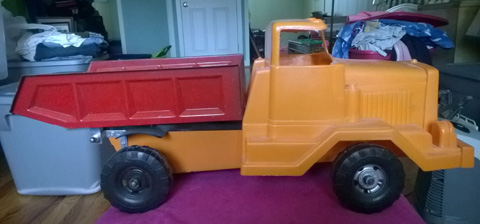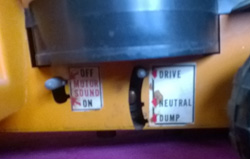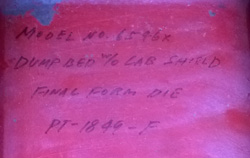 |
|
|||
 |
 |
|||
RINKER ON COLLECTIBLES — Column #1423 Copyright © Harry Rinker, LLC 2014
Questions
and Answers QUESTION: I own a Marx battery-operated, plastic dump truck. It has two control switches (1) a two-position on and off switch to control the “Motor Sound” and (2) three-position switch for drive, neutral, and dump. The dump truck is approximately 18 inches in length. The dump body is red and the cab and main body are yellow. There is a label on the body that reads: “Model No. 6546x / DUMP BED w/o CAR SHIELD / FINAL FORM DIE / PT-1849 – F.” I found several Marx battery-operated dump trucks in my internet search but was unsuccessful in finding an example that matched the one I own. What is your opinion? – DDeA, Reading, PA, Email Question
ANSWER: I also was unsuccessful in an internet search to find a production model that was identical to the example that you own. The Marx “Big Job” dump truck, Model #5216,” first marketed in 1964, was the closest. The differences between the “Big Job” dump truck and your example far outweigh the similarities.
Until a mass production dump truck is found that matches your example, the safe assumption is that you have a factory prototype that never went into production. Advanced collectors love prototypes because they tend to be one-of-a-kind items. If placed at auction, I would not be surprised if the final hammer price exceeded $250.00. QUESTION: I have a portfolio entitled “History of Michigan” featuring 24 of 25 prints by Robert Thom. F. Clever Bald wrote the accompanying text. The prints measure approximately 20 inches by 16 inches. The series of paintings was commissioned by Michigan’s Bell Telephone Company. When were the prints done, and what is the portfolio worth? – D, Atlanta, MI ANSWER: Robert Alan Thom was born March 4, 1915 in Grand Rapids, Michigan and died in Alma, Michigan on December 31, 1979. After studying with Robert Brackman, he worked as a commercial illustrator for General Motors and Detroit Edison. He established an independent art studio in 1945. Thom specialized in creating paintings and prints of historical scenes, including series for large commercial clients. In addition to your series, he created series for Chevrolet (history of baseball), Illinois Bell (Indiana history), Kimberly-Clark (history of “Graphic Communication through the Ages”), and Parke-Davis (45 paintings focused on the history of medicine and 40 paintings focused on the history of pharmacy). [See: http://en.wikipedia.org/wiki/Robert_Thom_%28illustrator%29] Thom created his “A History of Michigan in Paintings” series between 1964 and 1967. The series was issued in six sets, the final set containing five instead of four prints. The titles are: Set 1: Before History: 10,000 B.C.; Michigan Indians: Algonquin village about 1500 A.D.; Sieur de La Salle and the “Griffon”: St Ignace, August 27, 1679; Massacre at Michillmackinac, June 2, 1763 Set 2: Mne. Cadillace arrives at Detroit: October 1701; Perry transfers to the “Niagara”: September 10, 1813; The Americans take over Fort Mackinac: September 1, 1796; Lewis Cass expedition: May 25-September 23, 1820 Set 3: Douglass Houghton finds copper: 1840: The Capitol moves to Lansing: January 3, 1848; Charles Harvey builds the locks: 1853-1855; Putting the world on wheels: 1913 Set 4: When Pine was king: 1840-1890: The Detroit fire: June 11, 1805; Furs-Trappers-Traders: 1660-1850; The boy governor: July 24, 1831 Set 5: Detroit-world port: 1965: Joliet and Marquette: May 17, 1673; The pageant of the Sault: June 14, 1671; The one-room school: 1861 Set 6: Michigan in the Civil War: 1861-1865; Michigan fever: 1836; The iron horse: July 1837; Riches underground: 1966; Arsenal of Democracy: World War II The pamphlet booklets are tri-fold. The print size is 16 1/4 inches by 11 inches. The overall measurement is 23 3/4 inches by 11 inches. When closed the booklet is 8 1/4 inches by 11 inches. An eBay seller has a set of 18 Thom “History of Michigan” prints for $40.00, or $2.25 per print. The asking price for Thom’s medicine prints ranges from $7.50 to $15.00. Many sellers frame the prints, thus enhancing the value to the $20.00 to $25.00 range. The value of your portfolio is regional. In Michigan, it might command as high as $75.00 to $90.00, roughly$3.00 to $3.50 per print. In other states, its value is between $35.00 and $45.00. QUESTION: I have several Lionel trains and Lionel accessories that have been handed down from my grandfather and dad. I am trying to determine their value. The trains range from the 1960s through the 1980s. What sources do you recommend for checking out their value? – JB, Schuylkill Haven, PA, Email Question. ANSWER: Lionel trains and accessories have a three- or four-digit code number on them. List your pieces—locomotive, rolling stock, track, and accessories—noting the code number found on each. Using Google, type in the search box: Lionel +(the number). This should produce dozens of price listings for each item. In order to compare apples to apples, do an honest assessment of the condition of the Lionel items you own. Do the engines and accessories featuring movement still work? Are the pieces “like new” or do they show evidence of play? Pay no attention to “Buy it Now” and other direct sale price listings. These are asking prices, not actual sale prices. Focus only on examples that have sold through, often one-third or less of most asking prices. Period boxes are critical to value. If they are missing, value is decreased by 10 to 20 percent. Sets, especially when still in their period boxes, command a premium. There are sites where you can find the locomotive and rolling stock numbers that make up a store bought set. The value of price guides is to identify what constitutes a complete unit and the variations available within a single number. Although the pricing structure is no longer valid, I favor the older Greenberg guides, available through interlibrary loan at your local public library, for this purpose. Kalmbach recently published the 2014 edition of its “Greenberg’s Pocket Guide to Lionel Trains.” Prices are dealer list. For an accurate value of what your trains are worth, cut the prices in half. Another alternative is to visit a toy train show. There are a number in eastern Pennsylvania. They are listed on trains.com. Finally, your trains are “recent” by toy train collecting standards. Keep your financial expectations conservative.
ANSWER: I love family stories. They help make inanimate objects come alive, and your vase comes with a wonderful family story. The vase is decorated bisque. Bisque is the first firing of green-ware (damp porcelain). Its shape and color suggest a date of around 1900. The 1880s is too early. If I look at it without your story, I would date it around 1910. The date difference does not impact its value. The design suggests the Art Nouveau period. The “natural” look, sculpture objects that appear to emanate from the earth, was quite popular. The overall appearance of the vase is “forestry.” Your vase has more family than collectible market value. Its distinct shape allows for some conversational value. A fair secondary market value is between $20.00 and $30.00.Harry L. Rinker welcomes questions from readers about
collectibles, those mass-produced items from the twentieth and twenty-first centuries.
Selected letters will be answered in this column.
Harry cannot provide personal answers.
Photos and other material submitted cannot be
returned.
Send your questions to: Rinker on Collectibles, 5955 Mill
Point Court SE, Kentwood, MI 49512.
You also can e-mail your questions to
harrylrinker@aol.com.
Only e-mails containing a full name and mailing address
will be considered.
You can listen
and participate in
WHATCHA GOT?, Harry’s
antiques and collectibles radio call-in show, on Sunday mornings between 8:00 AM
and 10:00 AM Eastern Time.
If you
cannot find it on a station in your area,
WHATCHA GOT?
streams live on the Internet at www.gcnlive.com.
SELL, KEEP OR TOSS?: HOW TO DOWNSIZE A HOME,
SETTLE AN ESTATE, AND APPRAISE PERSONAL PROPERTY
(House of Collectibles, an imprint of Random House Information Group, $17.99),
Harry’s latest book, is available at your favorite bookstore and via
www.harryrinker.com.
|
||||

 Marx’s golden age was in the 1950s. At the time, it had plants located in Erie and Girard, Pennsylvania and Glen Dale, West Virginia. Unfortunately, your email did not include how the dump truck came into your family’s possession. Did a parent, a relative, or friend of your parents work at the Girard plant or did you acquire it on the open market?
Marx’s golden age was in the 1950s. At the time, it had plants located in Erie and Girard, Pennsylvania and Glen Dale, West Virginia. Unfortunately, your email did not include how the dump truck came into your family’s possession. Did a parent, a relative, or friend of your parents work at the Girard plant or did you acquire it on the open market? Prototypes leave factories for a variety of reasons – employees take them home when the factory has no further use for them, manufacturers gift them to key clients and friends, they are trashed and retrieved by someone, or they are sold when a factory is closed or a company goes out of business.
Prototypes leave factories for a variety of reasons – employees take them home when the factory has no further use for them, manufacturers gift them to key clients and friends, they are trashed and retrieved by someone, or they are sold when a factory is closed or a company goes out of business. QUESTION: I have a miniature vase, measuring 6 inches high, that I inherited from my mother. Inside is a 1985 note that reads: “This is a Bisque Vase. It belonged to Great Grandmother Rickey and then my Grandmother, Bess Foster, then my mother, Kate Foster Wall, then to me Betty Wall Causey. It is about 98 years old or more.” My mother was 58 at the time she wrote that note. This suggests the vase is 130 years old or older. Grandmother Foster lived in a pre-Civil War home in Manor (near Austin), Texas. The house burned. The vase was the only thing saved. It was once part of a pair. What information can you provide? – DCB, Nocona, TX, Email Question
QUESTION: I have a miniature vase, measuring 6 inches high, that I inherited from my mother. Inside is a 1985 note that reads: “This is a Bisque Vase. It belonged to Great Grandmother Rickey and then my Grandmother, Bess Foster, then my mother, Kate Foster Wall, then to me Betty Wall Causey. It is about 98 years old or more.” My mother was 58 at the time she wrote that note. This suggests the vase is 130 years old or older. Grandmother Foster lived in a pre-Civil War home in Manor (near Austin), Texas. The house burned. The vase was the only thing saved. It was once part of a pair. What information can you provide? – DCB, Nocona, TX, Email Question